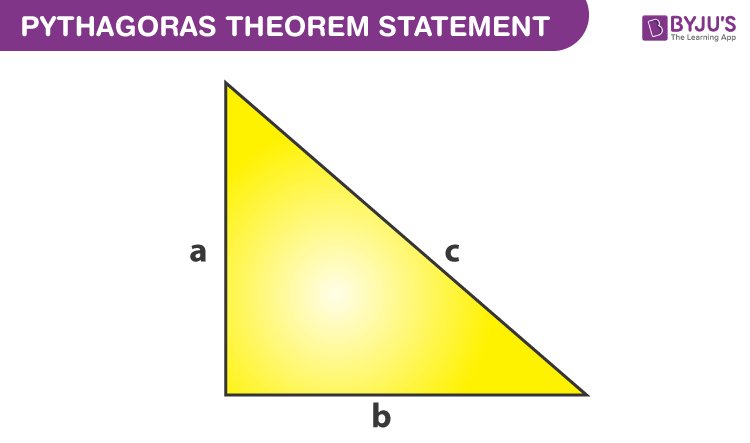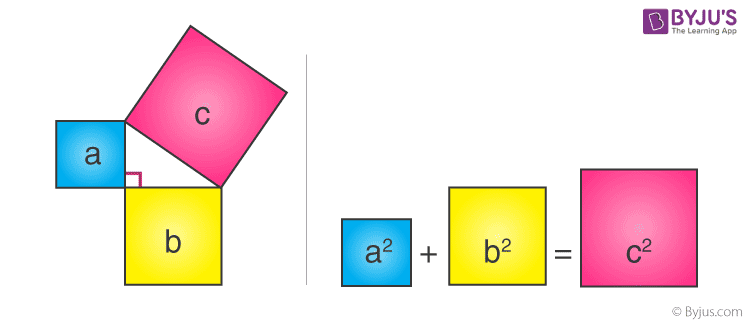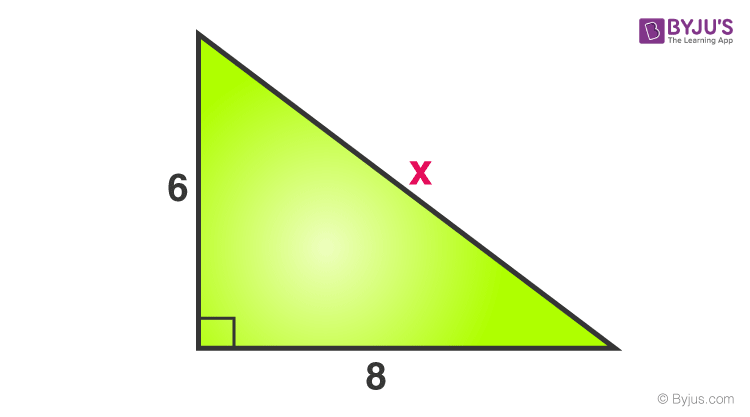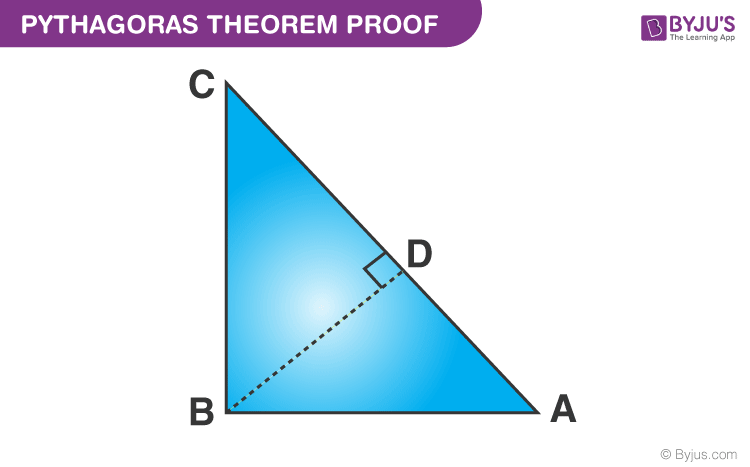Pythagoras Theorem is an important topic in Maths, which explains the relation between the sides of a right-angled triangle. It is also sometimes called the Pythagorean Theorem. The formula and proof of this theorem are explained here with examples.
Pythagoras theorem is basically used to find the length of an unknown side and angle of a triangle. By this theorem, we can derive base, perpendicular and hypotenuse formula. Let us learn mathematics of Pythagorean theorem in detail here.
Table of Contents:
Pythagoras Theorem Statement
Pythagoras theorem states that “In a right-angled triangle, the square of the hypotenuse side is equal to the sum of squares of the other two sides“. The sides of this triangle have been named as Perpendicular, Base and Hypotenuse. Here, the hypotenuse is the longest side, as it is opposite to the angle 90°. The sides of a right triangle (say a, b and c) which have positive integer values, when squared, are put into an equation, also called a Pythagorean triple.

History
The theorem is named after a greek Mathematician called Pythagoras
Pythagoras Theorem Formula
Consider the triangle given above:
Where “a” is the perpendicular side,
“b” is the base,
“c” is the hypotenuse side.
According to the definition, the Pythagoras Theorem formula is given as:
| Hypotenuse2 = Perpendicular2 + Base2 c2 = a2 + b2 |
The side opposite to the right angle (90°) is the longest side (known as Hypotenuse) because the side opposite to the greatest angle is the longest.

Consider three squares of sides a, b, c mounted on the three sides of a triangle having the same sides as shown.
By Pythagoras Theorem –
Area of square A + Area of square B = Area of square C
Example
The examples of theorem based on the statement given for right triangles is given below:
Consider a right triangle, given below:

Find the value of x.
X is the side opposite to right angle, hence it is a hypotenuse.
Now, by the theorem we know;
Hypotenuse2 = Base2 + Perpendicular2
x2 = 82 + 62
x2 = 64+36 = 100
x = √100 = 10
Therefore, we found the value of hypotenuse here.
Pythagoras Theorem Proof
Given: A right-angled triangle ABC, right-angled at B.
To Prove- AC2 = AB2 + BC2
Construction: Draw a perpendicular BD meeting AC at D.

Proof:
We know, △ADB ~ △ABC
Therefore,
Or, AB2 = AD × AC ……………………………..……..(1)
Also, △BDC ~△ABC
Therefore,
Or, BC2= CD × AC ……………………………………..(2)
Adding the equations (1) and (2) we get,
AB2 + BC2 = AD × AC + CD × AC
AB2 + BC2 = AC (AD + CD)
Since, AD + CD = AC
Therefore, AC2 = AB2 + BC2
Hence, the Pythagorean theorem is proved.
Note: Pythagorean theorem is only applicable to Right-Angled triangle.
Applications of Pythagoras Theorem
- To know if the triangle is a right-angled triangle or not.
- In a right-angled triangle, we can calculate the length of any side if the other two sides are given.
- To find the diagonal of a square.
Useful For
Pythagoras theorem is useful to find the sides of a right-angled triangle. If we know the two sides of a right triangle, then we can find the third side.
How to use?
To use this theorem, remember the formula given below:
c2 = a2 + b2
Where a, b and c are the sides of the right triangle.
For example, if the value of a = 3 cm, b = 4 cm, then find the value of c.
We know,
c2 = a2 + b2
c2 = 32+42
c2 = 9+16
c2 = 25
c = √25
c = 5
Hence, the third side is 5 cm.
As we can see, a + b > c
3 + 4 > 5
7 > 5
Hence, c = 5 cm is the hypotenuse of the given triangle.
How to find whether a triangle is a right-angled triangle?
If we are provided with the length of three sides of a triangle, then to find whether the triangle is a right-angled triangle or not, we need to use the Pythagorean theorem.
Let us understand this statement with the help of an example.
Suppose a triangle with sides 10, 24, and 26 are given.
Clearly, 26 is the longest side.
It also satisfies the condition, 10 + 24 > 26
We know,
c2 = a2 + b2 ………(1)
So, let a = 10,b = 24 and c = 26
First we will solve R.H.S. of equation 1.
a2 + b2 = 102 + 242 = 100 + 576 = 676
Now, taking L.H.S, we get;
c2 = 262 = 676
We can see,
LHS = RHS
Therefore, the given triangle is a right triangle, as it satisfies the theorem.
Pythagorean Theorem Problems
Problem 1: The sides of a triangle are 5,12 & 13 units. Check if it has a right angle or not.
Solution: From Pythagoras Theorem, we have;
Perpendicular2 + Base2 = Hypotenuse2
Let,
Perpendicular = 12 units
Base = 5 units
Hypotenuse = 13 units
122 + 52 = 132
⇒ 144 + 25 = 169
⇒ 169 = 169
L.H.S. = R.H.S.
Therefore, the angle opposite to the 13 unit side will be at a right angle.
Note : IMAGES BY BYJUS LEARNING APP




No comments:
Post a Comment